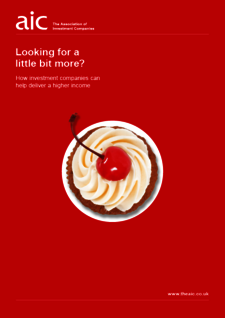Choosing an investment company
Time to open up a world of investment opportunity.

Choosing an investment company
Before you start thinking about what to invest in, it’s important to know what you are investing for. Is it for income in retirement perhaps, or maybe to grow wealth for a pension or to build a nest egg for children?
If you don’t know yet, have a look at the ‘New to investing?’ section of this guide.
If you know your goals and have decided you’d like to invest in an investment company, it’s important that you don’t choose one based on its past performance. If an investment company generated a good return in the past, or produced an income, that’s not a guarantee it will do the same in future.
Looking for a little bit more?
With interest rates falling to record lows in recent years, finding income has probably never been harder.
This guide explains some of the unique features that give investment companies a head start over other funds when it comes to delivering income.

What you should consider
A company’s basic structure and goals are far more important than its past performance. You should make sure it suits your individual needs.
Make sure you know:
- What the company invests in.
- Its charges.
- Whether it fits your own investment objectives.
- Whether it invests in line with your values and beliefs (see “ESG”, below).
- How risky it is likely to be. You could assess this in a few ways:
- What it invests in.
- How concentrated or diversified its portfolio is.
- Its approach to gearing (borrowing money to invest).
- How much its share price has tended to move up and down in the past (always remembering that things might not be the same in future).
ESG
Increasingly, people want to choose investments that are in line with their personal values and beliefs.
The term “ESG” is used as a shorthand for environmental, social and governance factors that people might want to consider when investing.
Find out more about ESG
Investment company performance figures and what they mean
Where possible, the AIC gives past performance figures for every member investment company listed on its website.
These figures are almost always given on a “total return” basis. This means that any dividends received are considered to have been reinvested.
Share price returns and NAV returns
An investment company’s performance can be measured in two ways and the AIC’s website shows both:
- Share price total return (%) – the performance of an investment company’s shares. It is the return investors actually receive.
- NAV (net asset value) total return (%) – the performance of an investment company’s underlying portfolio. It doesn’t take any discount or premium at which the shares may have traded into account. It is not the return an investor receives, but it can be used to judge the fund manager’s performance.
Costs
Share price total return and NAV total return take some costs into account. The costs of running the investment company such as fund manager fees and accounting costs are reflected in the performance figures.
Costs paid by the investor which are external to the investment company, such as stamp duty or fees for buying and selling investment company shares, are not included.
Benchmarking
Most investment companies have a benchmark which they use to measure their performance. At the end of an investment company’s financial year, the board will report on whether it beat or underperformed its benchmark.
The benchmarks used are often indices which match the investment company’s investment strategy, the FTSE 100 or FTSE SmallCap, for example.
You can normally see how an investment company has performed against its benchmark on its monthly factsheet. Investment company factsheets are available on the AIC’s website.
Want to see past performance figures?
Sector classification
The AIC classifies investment companies into different sectors to help you find and compare them.
Why is sector classification important?
When you’re choosing an investment company, the range of choice can be baffling. Investment companies are arranged into sectors to help you find and compare them.
For example, if you are looking for income, you might want to consider sectors that specialise in delivering a high or growing income, such as UK Equity Income or Global Equity Income.
Sectors make it easier to compare the performance and costs of investment companies with similar objectives.
What do the AIC sectors mean?
The AIC classifies all investment companies into sectors, usually based on one of the following:
- Regional focus. For example, Japan.
- Industry focus. For example, Biotechnology and Healthcare.
- The company’s investment objective. For example, UK Equity Income.
There are rules to determine which investment companies go in which sectors, but no two companies are ever the same and there can be a lot of variation within a sector. It’s also important to remember there are no guarantees that investment companies will meet the objectives that apply to their sector.
See the AIC’s investment company sectors.
When it comes to costs, you can now compare ongoing fund charges on a like-for-like basis.

Costs
Costs are an important consideration when investing. The greater the costs, the harder your investments have to work to deliver you a return.
Typically, there are two types of costs when investing in investment companies:
- Internal costs – the costs and charges of the investment company itself, for example the annual management fee that goes to pay the fund manager.
- External costs – costs and charges outside the investment company, for example, dealing commission when you buy and sell investment company shares.
The internal and external costs together add up to your total cost of investing.
Internal costs: the costs of running an investment company
Internal costs are paid out of the assets of an investment company. For most investment companies, they are likely to include the following:
- Annual management charge – paid to the fund management group that manages the portfolio of the investment company from day to day. Most annual management charges fall somewhere between 0.5% and 1.5%. Some investment companies will also pay the fund management group a performance fee if the company’s performance exceeds an agreed target.
- Transaction costs – when the fund manager buys and sells assets within the investment company’s portfolio.
- Gearing costs – if the investment company uses gearing. This might be, for example, interest paid on a bank loan that the investment company has taken out.
- Fees of professional services firms – such as accountants and lawyers.
- The fees of the board directors.
- Costs of holding shareholders’ meetings.
- Costs of producing the annual and semi-annual report – and other shareholder communications.
- Other administration costs.
You can find out about all the costs incurred by an investment company in its annual accounts.
When you see performance figures quoted for an investment company, all these costs will already have been taken out. You are seeing the net figure (after internal costs).
External costs: costs outside the investment company
External costs are paid directly by you, the investor. They don’t come out of the assets of the investment company.
Typical external costs might include:
- Dealing commission – when you buy or sell shares using a platform or broker. This varies considerably but a typical amount would be approximately £10 per buy or sell.
- Dealing spread – is the difference between the ‘buy’ price and the ‘sell’ price (known as ‘bid’ and ‘offer’).
- Stamp duty – when you buy shares in UK-based investment companies. This is 0.5% of the purchase amount, and is paid only when you buy (not when you sell). So when you buy £100 of shares you pay 50p stamp duty.
- Any other taxes – you have to pay on income or gains.
- Platform charges – most investors now hold their investment company shares on platforms. On a platform, you’ll typically pay admin charges as well as dealing commission. The AIC offers comprehensive data on charges for holding investment companies on platforms.
- The cost of financial advice – if you are using an adviser.
Two people investing in the same investment company will pay the same internal costs, but their external costs might be very different depending on the platform or broker they use, whether or not they use a financial adviser, and their tax position.
Where do I find out about costs?
You can find out about the internal costs of investment companies on this website. We can’t provide comprehensive information on external costs, as they depend on the investor’s choices, such as how often they buy and sell shares, but we do maintain cost comparison tables which give you an idea of what platforms will charge you to buy, sell or hold investment companies.
When it comes to internal costs, you can look up the AIC ongoing charge for any member investment company.
The AIC ongoing charge
The AIC ongoing charge has been designed to make it easy for you to compare the costs of investment companies with other funds, such as open-ended funds. It is made up of the regular, recurring costs of running an investment company, such as:
- The annual management charge.
- Fees of professional services firms – such as auditors.
- The fees of board members.
- Administration costs.
The AIC ongoing charge is backward-looking. It calculates costs for the last financial year, and divides these by the net assets of the company to produce a percentage figure.
See exactly how the AIC ongoing charge is calculated.
The AIC ongoing charge does not include performance fees. On this website, you can find a figure called AIC ongoing charge plus performance fee, which includes the performance fees paid in the last financial year. Where this figure is the same as the AIC ongoing charge, it means no performance fees were paid.
Finally, you’ll find details of the management agreement between the investment company and its manager, which sets out what annual charges apply, and whether there is a performance fee.
The AIC ongoing charge does not include transaction costs, which are the costs paid when a fund manager buys or sells assets within the investment company’s portfolio. It also excludes gearing costs.
Charges on Key Information Documents
Since 1 January 2018, investment companies have been required to produce Key Information Documents (KIDs). The charges disclosed on these KIDs vary from the AIC ongoing charge.
There are two main differences between the KID charge and the AIC ongoing charge:
- KID charges attempt to be forward-looking, to give you an idea of what you may pay in future, whereas the AIC ongoing charge gives you the real costs paid in the previous financial year.
- KID charges include transaction costs, gearing costs and performance fees (where paid), which are not included in the AIC ongoing charge.
The AIC believes that there are various problems with KIDs. One of these is that open-ended funds have been told they do not have to produce KIDs yet. In the meantime, they will continue to produce a different sort of document called the Key Investor Information Document (KIID), which discloses charges on a different basis.
KIDs and KIIDs may sound similar, but in reality the cost disclosures on the two documents are very different! This raises the risk of misleading “apples and pears” comparisons being made between the costs of investment companies and open-ended funds.
The AIC will continue to display the AIC ongoing charge on its website, to allow investors to make informed comparisons between the costs of investment companies and those of open-ended funds.
How can I keep my costs down?
Costs have a big impact on investing, especially over long periods. Let’s say you invested £10,000 for ten years and markets returned 6% a year. If your charges were 0.5%, your return would be £17,081 over the ten-year period. But with charges of 1%, your return goes down to £16,289 – a difference of £792.
When you choose an investment company, you should carefully consider that company’s costs. Bear in mind that investment companies that invest in more specialist assets (such as property, private equity or infrastructure) are likely to have higher charges than those that invest in more conventional assets such as shares or bonds. So it may help to compare an investment company’s charges with others in its AIC sector.
Large investment companies often have lower costs than smaller ones. This is due to economies of scale, which are often passed on to shareholders as companies grow. Remember that external costs, such as platform costs, matter too. You can compare the costs of different platforms when holding investment companies on this website.



